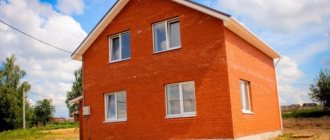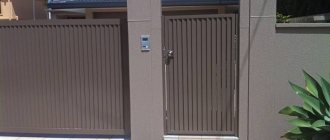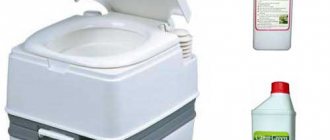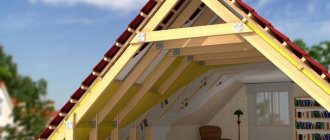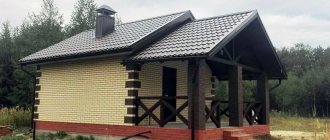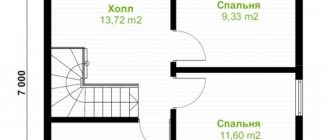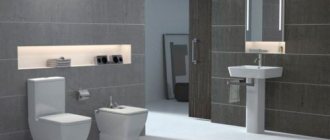A good-quality frame bathhouse is not just a room for washing. A well-thought-out structure looks harmonious inside and out, pleases with its atmosphere and consistent style, and matches the landscape. Detailed modern designs for frame baths allow you to build a reliable, durable structure that will last for many years. If you dream of taking a steam bath in the near future, having a pleasant rest and recharging your energy, the technology for constructing frame baths opens up all these possibilities for you. In a short time, with an affordable budget and excellent results.
Floor design in a frame bath
Compliance with all recommendations and instructions for installing the floor will increase the service life of the bathhouse.
A well-made floor will protect against heat loss and rotting of floor boards. In bathhouses where there is direct contact with water, the floor is poured. The most important thing in pouring floors is to ensure rapid flow of water into the sewer.
Step-by-step instructions for installing the floor:
- Laying lags. If the distance between the supports is large – more than 3 m – additional support pillars are needed. Use roofing felt for waterproofing in several layers at the junction of the joists with the foundation and supports.
- For clay soil, a tray is made under the structure to direct water into the drainage pit.
- Installation of boards on joists. The gap for pouring flooring between the boards is about 4 mm. A gap of 2 cm should be left between the flooring and the wall of the bathhouse.
In other rooms of the bathhouse, the floor is non-leakage. To arrange it, 5x5 cm bars are mounted on the logs, and a subfloor is laid on top of them.
Scheme of floor insulation in a frame bath. A waterproofing layer is laid on the subfloor, then mineral insulation is laid on top of which a vapor barrier is laid
After the vapor barrier layer, you can begin installing the finished floor.
Walling
The construction of the walls of a frame bath begins with the construction of the supporting part on which they will be located. After the piles have fully gained strength, which occurs after two to three weeks, the lower frame is constructed. To make it for a frame bath, you need to cut out parts from the existing timber, the size of which was indicated above, that will correspond to the length of the walls of the bath. At the corners, parts of the sauna harness are connected to each other. To do this, it is better to use a half-beam connection. On each of the components, a cut is made with a depth of half the timber and a width that will be equal to the width of the timber that will be laid in it. After this, holes are drilled in the places where the prepared studs stick out. It is necessary to lay roofing felt waterproofing on concrete supports, which will not allow moisture to seep into the wood. The studs are inserted into the beams of the sauna frame and the pressure is applied using nuts and washers. Part of the hole must be drilled out so that the nut and washer are flush.
The next step is to install the four main pillars of the bathhouse walls in the corners. They can be made from the same timber as the sauna frame. They can be secured using metal corners and further strengthened with a tenon joint. They are leveled and secured with jibs so that there is no shift in their position. After this, the upper harness is made according to the principle of the lower one. In order for the structure to have sufficient strength, additional spacers are installed from 15x5 cm boards. They must be placed in the wall with a step that will be equal to the width of the insulation that will be used. Additional racks are mounted where windows and doors will be installed in the bathhouse. The beams of the upper and lower trim, as well as additional supporting elements, must also be mounted on the internal partitions.
Note! If you want to build a pitched roof on a frame bathhouse, you need to make sure that one wall is higher than the other.
The construction of the main frame of the bathhouse can be considered complete. Now the subfloor is laid so that you can move freely around the internal space for further installation work. The logs are attached from the boards that were used for additional racks or from the timber that was used for strapping. From above, the entire space is covered with a butt board. You can clearly see the process of assembling the lower trim for the bath in the video.
Preparation for construction: project drawings
Creating a drawing requires certain skills. If they are not there, then it is better to entrust this work to a specialist or use a ready-made drawing.
Before drawing up a diagram, it is important to decide on the following points:
Location of the building on the site
It is important to consider sewer and water drainage. Quite often, the main factor when choosing a location is the laying of communications.
Soil at the construction site
If you plan to make a swimming pool in a bathhouse, then groundwater should not be located near the surface of the territory. The type of foundation to be built will also depend on the type of soil. Bathhouse construction plan and number of floors. If you plan to make a two-story building, it is important to take into account the additional load on the frame structure and foundation. At this stage, you should think in advance about the placement of the stove and what material it will be made of. This will allow you to understand where and which chimney to install, as well as the ventilation passages in the room. Laying communications. It is important to take care of ventilation, electrical wiring, vapor barrier and thermal insulation. It is worth considering the features of water drainage. An important element of any building is the roof. The service life of the structure will depend on it. You should take into account the material of manufacture, as well as its shape. This will allow you to calculate the power of the floors.
You need to include all the information received in the drawing, as well as supplement the project with the necessary details. The more detailed the diagram, the easier it is to build a bathhouse.
The more detailed the project, the easier it is to make a frame bathhouse yourself
It is recommended to draw up a separate plan for communications. If you have little experience, you should not create a complex project. You can use a ready-made diagram, slightly supplementing it based on your own needs.
A standard bath includes a corridor, a dressing room, a washing room and a steam room.
A standard frame bath consists of a dressing room, steam room, shower and rest room
Quite often a separate room for recreation is provided. It is recommended to mark the installation location of the stove on the diagram. If this is a steam room, then it is best to place the stove in the corner closest to the door. The stove can be stone or brick.
It is recommended to determine in advance the dimensions of each room and indicate them in the drawing. The standard dimensions of the steam room are 200x240 cm. The optimal ceiling height is 220 cm. This design can accommodate 2-3 people at the same time.
In the drawing you can see a bathhouse for a suburban area with a balcony measuring 1.5x4 m. The overall dimensions of the building are 4x6 m. The project is suitable for organizing gatherings in an open area in the summer.
A frame bath can be equipped with a terrace for gatherings in the warm season
This bathhouse consists of 3 rooms:
- steam room;
- washing and shower;
- rest room.
The corridor is shown separately in the diagram. There is no room for a locker room. There is a small changing area in the washing room. The terrace connects to the living room.
The optimal wall thickness of a frame structure is 100 mm or more. The wood that is used in the process of making a bath must be treated with an antiseptic. It is recommended to use dried, calibrated lumber.
It is mandatory to perform a vapor barrier of the insulating material on the internal base. In the steam room you need to use foil vapor barrier. The reflective layer can increase the temperature inside the steam room.
Supply and exhaust ventilation is required in all rooms. Floors in the sink should be made with a slight slope or along a screed. The top and bottom floors need to be insulated in the same way as the walls.
The minimum size of a frame bath is 3x4 m.
The minimum size of a bathhouse for a comfortable stay of several people is 3x4 m
The budget version of the frame is made in this way: the racks are sheathed on the inside and outside with boards up to 25 mm, basalt insulation or ecowool is laid inside the frame structure.
If you plan to use ecowool inside the walls, it should be carefully compacted and horizontal platforms for unloading should be installed. The frame must be sheathed inside and outside. To do this you will need to make a sheathing. On the outside, the insulation material is covered with a membrane to protect it from the wind. In the horizontal plane, the use of ecowool is a more economical option compared to basalt insulation.
The outside of the frame structure can be covered with any facing material. The inside of the building is covered with clapboard, plasterboard sheets with tiles or imitation timber.
Tips for finishing and insulation
The outside of the bathhouse is covered with siding, boards, plaster or ceramic tiles. Waterproofing material should be laid under the sheathing. The resulting gaps can be filled with thermal insulation material. You need to leave a small gap between the clapboard and the foil for ventilation. For this purpose, strips several cm thick should be nailed to the vertical supporting parts. The distance between the elements must be selected taking into account the distance between the supports.
In the diagram you can see the design of the wall cladding
To give rigidity to the walls, they need to be covered with plaster shingles. After the cladding work is completed, the outside of the structure must be plastered.
Guidelines for internal cladding of frame buildings:
- The inside of the building should not be painted, as paints and varnishes will release harmful chemicals when heated.
- To make a rough ceiling, you should use OSB boards. They must be secured to the bottom of the floor beams.
- The walls in the steam room should be covered with foil. The remaining walls can be covered with glassine.
- The minimum ceiling height is 2.2 m. In this case, it will be possible to install lining and additionally insulate the ceiling.
- It is important to pay attention to the joints between the walls and the ceiling structure. The vapor barrier material must protrude at least 15 cm.
The slats can be nailed in using different methods - during the fitting process, a selection is made into a groove or a quarter. The slats must be attached to the joists with the front part.
There is no need to make holes between the foil and the corrugated sheet; the sheets are nailed to the foil. Fixation is done using self-tapping screws with rubber gaskets.
After this, the furnace and boiler are installed. It is important to remember fire safety rules. The wall that will be used for the soaring room and resting place must be made of brick. It is recommended to place the heating boiler in the dressing room. The best option is a brick stove, but if you have no experience in laying a similar structure, it is recommended to entrust this work to a qualified stove-maker.
When working with foil, you need to be careful, as the material is easily damaged. Any gaps will significantly reduce the effectiveness of thermal insulation. The vapor barrier should be fixed with a stapler, and it is important to ensure that there is no sagging of the material. The minimum distance between the wooden paneling and the insulating material is 1 cm.
In the bathhouse, it is best to attach the foil using an ordinary stapler
Frame structures are convenient in terms of finishing. Work can be done both inside and outside. If there is a forced break, you can make partition frames at this time, upholstering them with blockhouse or clapboard. In this case, the time will be spent usefully.
For most regions, the optimal thickness of the walls of a frame building is 10 cm. Insulation can be done either with mineral wool or with expanded polystyrene. A layer of mineral wool 12 cm thick can replace a wall made of bars 50 cm thick.
You can insulate a bathhouse from the inside using mineral wool
For northern regions with cold climates, there are 2 methods of insulating a bath:
- Making a frame from slats 15 cm thick. The insulating material must be of identical thickness.
- Sheathing the walls on the outside with OSB sheets or plywood, followed by installation of expanded polystyrene boards 5–10 cm thick.
For the northern regions, it is recommended to cover the outside frame with OSB boards
If you plan to use expanded polystyrene, then after installing the sheets you need to make a thin screed using a mesh of reinforcement. Finally, a topcoat should be applied.
It is not recommended to use traditional insulation materials made from sawdust and straw.
It is not recommended to use sawdust and clay to insulate the ceiling
During the cooking process, they will be mixed in water with clay, and therefore the insulation will have a lot of weight. In addition, a large amount of liquid often causes wet ceiling parts made of wood. This has a negative impact on the performance characteristics of the bathhouse building.
Frame walls are an excellent bait for rodents who love polystyrene foam. In 2–3 years, solid sheets can turn into dust. Therefore, it is not recommended to use polystyrene foam for insulating rooms inside a frame structure.
Particular attention should be paid to the quality of vapor and waterproofing. Such a bathhouse does not have free supports; each of them will carry the load and hold other parts of the building. If the strength is compromised due to prolonged exposure to moisture with one rack, the sauna may become unstable. In this case, complex repair work will be necessary. It is best to prevent such a situation at the stage of insulating the rooms.
To insulate the insulation, it is best to use aluminum film.
It is best to insulate the insulation with aluminum film
However, the material is not cheap. If you want to save money, you can use plastic film. The material is cheaper, but in terms of steam and water protection parameters it is practically not inferior to foil. It should be remembered that polyethylene can be damaged when exposed to sunlight. For this reason, it is important to cover the frames. This will reliably protect the film from exposure to ultraviolet radiation.
Construction of a foundation for a country frame-panel bathhouse
The usual construction of a strip foundation for a building requires 1/3 of the total financial costs for construction and the same amount of time. Due to the fact that our construction will be lightweight, the foundation can be carried out according to a simplified scheme, but a strip or pile structure would lead to an unreasonable increase in the cost of the entire construction. We will make the supporting part of the frame from “bald” car tires filled with crushed stone. After construction is completed, the tires should be protected from sunlight. This will prevent them from breaking. Features of constructing a foundation for a bathhouse in the country:
- After breaking down the perimeter of our bathhouse, the plant layer of fertile soil is cut off from its inside and carefully moved to the garden. As a result of this procedure, you should get a mini-pit 3.5x5 m with a depth of 0.15 m.
- Its bottom is compacted by rolling a heavy steel barrel over it. Then the entire area needs to be covered with fine crushed stone and also “rolled”. As a result, we received a dense crushed stone cushion for the bathhouse in the country, which in the future will evenly distribute the entire load from the structure.
- It is necessary to hammer one peg into the places where the tires will be installed.
- Then the tires are laid throughout the area so that the center of each of them coincides with the peg. The future foundation must be leveled in a horizontal plane. For this, a flat board 4 m long and a building level are used.
- After all the tires are leveled, a pad of any waterproofing material is placed inside each of them to prevent rubble from spilling out when working with the tires. All tires are covered with crushed stone in layers, with each of them compacted.
- Backfilling must be stopped before reaching the edge of the inner rim 5 cm. The crushed stone inside the tire is moistened, and its entire internal cavity is filled with Knauf cement mixture with the addition of filler. Thus, all lying tires should be filled to the very top at the same level.
- After polymerization of the concrete mixture, we obtain a durable layer in the rubber “formwork” that transfers the load to the crushed stone cushion. The rubber of tire beads serves as a compensator for periodic freezing and thawing of the soil.
As a result, when constructing such a foundation, we almost avoid excavation work and have a small consumption of materials: car tires d = 70 cm - 10 pcs., crushed stone - 3 m3, KNAUF mixture - 75 kg, roofing felt - 1 roll. The beam of the lower trim of the frame is installed on supports made of tires.
Flaws
In addition to many advantages, when constructing a frame building there are also some disadvantages:
- The construction of the building itself requires little money compared to other buildings, but it requires considerable cash injections for finishing and insulation (insulation may be inexpensive, but membrane films also cost money;
- The process of closing the insulated frame should be completed within 1.5 - 2 weeks (or even faster, until the insulation gets wet and is not torn by the wind);
- The impossibility of using inexpensive cotton wool and polystyrene foam for insulation (this is a plus about environmental friendliness);
- Finishing with slabs is not recommended in most cases; a ventilated façade is needed.
High cost of finishing
As described earlier, despite the seemingly cheap construction of a bathhouse at first glance, its finishing requires significant costs. Finishing, both external and internal, is the most expensive of the entire process of building a frame bath.
Requirements for the quality of insulation
The disadvantage of the “frame” is the impossibility of using cheap materials as insulation. Only high-quality and therefore more expensive insulation options are suitable.
We also recommend reading the following materials:
- Insulation of the walls of a frame bath;
- Insulation for the walls from the inside and what kind for the steam room;
- Which insulation is better, and also about foil and foil.
Speed Requirements
The construction takes a little time from the developer, but requires proper treatment (the insulation must be closed, otherwise it will get wet - as a result, you will have to buy it a second time, since it can be easier to throw it away than to dry it).
Ventilation requirements
Ventilation is simply necessary for frame construction. Ventilation maintains the necessary microclimate in the building at any time of the year. Unlike hygroscopic wooden walls, frame walls with their vapor barrier create the effect of a “plastic bag” in the bathhouse, similar to a greenhouse or greenhouse. It quickly becomes hot, but at the same time stuffy, you can simply suffocate if there is no ventilation.
We recommend reading about ventilation: in the steam room, diagrams and design, how to do it correctly.
Vapor barrier requirements
The bathhouse requires masterful work with membrane film. If the insulation is carried out with breaks or the joints are poorly sealed, the insulation will get wet and simply stop working.
Shrinkage
The insulated frame must be “closed” within two weeks. The actual shrinkage of raw lumber or “natural moisture” may take a slightly longer period. When the frame boards dry out, construction defects may appear: cracks, film breaks, and cold bridges may appear.
Weakness to wind and snow loads
Despite the fact that the frame is resistant to seismic activity, it is weak against snow and wind loads. The consequence is that the frame should be built in certain areas of the country where these weather conditions are least likely to manifest themselves or allowances should be made for them, which will increase the cost
This disadvantage should definitely be taken into account by everyone who wants to build a frame building.
Fast cooling
Despite the fact that the frame warms up faster, it cools down no slower than its “brothers” (stone, wood), but rather even faster. The reason is the same low heat capacity. The beam, log, stone must first be heated, while the “plastic bag” of the frame does not heat up, but only the air in it heats up. But even when the furnace stops, this air cools down quickly (after all, we will do ventilation, where without it, see above), and massive traditional materials can release the accumulated heat for a long time.
When choosing, you should take this fact into account.
Video: how to properly make a roof for a bathhouse from a log house with your own hands
Only if the roof of the bathhouse is installed correctly can you be sure that it will serve for many years and withstand any natural conditions. Therefore, the construction of this element must be taken very seriously and responsibly, since it takes on heavy loads, and therefore must be as strong and reliable as possible. And then you and your friends can enjoy relaxing in the steam room at any time of the year.
- Author: Elena Davydova
Rate this article:
- 5
- 4
- 3
- 2
- 1
(7 votes, average: 4.7 out of 5)
Share with your friends!
Selecting a frame bath project
On long winter evenings, we outlined the plan for our future bathhouse.
Photo of the frame bathhouse project we settled on.
Before choosing the material for building the bathhouse, we consulted with the builders for a long time. On their advice, we chose a standard design for a frame bathhouse installed on a pile foundation. This choice is due to the fact that groundwater in our area comes very close to the soil surface, and heaving soil can cause walls to crack if we use brick as a building material. Even if we use a strip foundation reinforced with piles, we still cannot get a 100% guarantee that it will withstand seasonal ground fluctuations.
Where to start building a bathhouse
Before starting the construction of a frame bath, it is worth planning the placement of the building. Pay attention to the following features:
- It is important to determine where the bathhouse will be located - separately or near the selected building on the site.
- Choose a place to install a bathhouse, taking into account the location of utility networks, and also mark the routes for laying communications.
- Find out the soil characteristics on the site in order to choose a foundation.
- Develop a new or choose an existing bathhouse project, taking into account your own requirements.
Advice!
The more detailed the bathhouse design is, the easier its implementation will be. Many organizations offer ready-made projects. You can also order an individual project from them. The minimum size is 3x4 m. The optimal aspect ratio of the bath is 5x5 m.
Roof arrangement
The roof of the bathhouse is made of the same boards with a cross-section of 150×50 mm.
In this case, you can assemble the rafter system on the ground and install it ready-made on the top frame. But first, you will need to install and secure a special beam (mauerlat) over the frame, which is used as the load-bearing base of the roof being built. Types of sheathing
After you install the rafter system, you can proceed to arranging the sheathing, made from boards 20 cm thick. Upon completion of laying the sheathing (which is usually carried out starting from the ridge), you can proceed to laying the roofing covering you have chosen.
Stage I. Design
So, let's move on to design. Of all existing roofs, the lean-to roof has the simplest design. This is where the builder’s eye rests: everything is simple and clear, like the sky above your head. Whether you create a project for a pitched roof of a house yourself, or hire a specialist, the following points should be considered in it:
- General sketch of a building with a roof.
- Carrying out separate viewing points of such a roof: in front, behind the house and on the sides.
- Full calculation of complex loads from snow, the weight of the rafter system and roofing.
- Drawing up sections of all important individual sections of the roof.
- A detailed diagram of the important components of the roof and the junction of the roofing covering to the rafter system.
- Description of all difficult places, especially the junction of the rafter system with load-bearing floors and walls.
- Scheme of drainage and snow clearers (or electrical cable).
Moreover, as practice shows, the main role in the final cost of the roof is played not so much by the footage, but by the presence of special elements: valleys, ridges, end strips and the like. This is why a pitched roof is beneficial in this regard as well.
Straight to the point: don’t confuse technologies!
If you think that a frame-panel bathhouse is the same as a frame bathhouse, just a more detailed and longer name, then carefully read the following sentences. A frame-panel building is built from ready-made panels, which are purchased from companies that professionally deal with them. A frame building can be built by any home craftsman with minimal construction skills and tools. The frame is erected, filled with insulation, sheathed and finishing work carried out. If you need such a frame bath, then go to the appropriate section. If you are still sure that you need information on panel buildings, then read on.
Photo: VIVA HAUS company
The main advantages of frame technology
Advantages of frame buildings:
- the design is simple and it is possible to design and build it yourself;
- the building does not shrink and finishing work and installation of equipment begin immediately after the main construction;
- construction proceeds quickly, without restrictions on the time of year;
- the lightness of the design makes it possible to install any type of foundation;
- Any materials for cladding are suitable. Everything depends on material capabilities;
- environmental friendliness of the building;
- economic benefit in comparison with stone and brick buildings.
To perform the work, it is not necessary to involve heavy equipment and a whole team of workers. Simple construction tools and a maximum of one assistant will do.
Stage III. We lay and insulate floors
In short, to make floors in a frame bath, you need to nail bars with a section of 5x5 cm to the bottom of their logs in the relaxation room, the steam room, and the dressing room, and lay subfloor boards on top of them, then roofing felt, and finally - mineral wool 10 cm thick or expanded polystyrene. And already under the boards of the finished floor you should lay glassine for vapor barrier:
In the washing room, the floor needs to be done differently:
- Step 1. So, in order for it to always be warm in cold times and dry quickly, you need to make a separate foundation along its entire perimeter.
- Step 2. Next, remove a layer of soil by half a meter, and fill the resulting pit with gravel and sand to a 10 cm layer. If water gets into such a drainage well, it will go into the ground, and there will be no need to make a pit.
- Step 3. For the logs of such a floor, it is best to use asbestos-cement pipes with a diameter of 10 cm, which are placed directly on the foundation and filled with concrete so that it keeps them from moving.
- Step 4. Then, in the washing room, a 4-5 cm thick edged round board is laid over the pipes, but with a gap of 6-7 millimeters with rubber gaskets, which are nailed.
- Step 5. After all this, the floor can be pressed down with baseboards.
More details in the video:
Video description
The process of manufacturing and installing rafters is shown in a very detailed and accessible video:
Roofing device
All that remains to do on the finished rafter system is to fill it with sheathing and cover it with the selected roofing material. If the roof needs to be insulated, then the insulating material is laid between the rafters, and on the inside it is covered with a vapor barrier film, securing it with transverse slats that will hold the insulation.
A waterproofing roll material is attached on top of the rafters, thus protecting the insulation on all sides from moisture penetrating into it. To create a ventilation gap, counter-lattice slats are fixed to the rafters, and the sheathing is mounted on them.
Diagram of an insulated roofing pie Source stroyvopros.net
Finally, the ridge is attached, the gables are sewn up and the eaves overhangs are formed.
Features of frame baths
Frame baths are built according to the usual rules for this technique, which makes it possible to do without the use of special equipment or “wet” sand-cement mortars. The important point is the ability to do everything yourself, at a time convenient for you. The main task is the need to understand the principle of creating frame buildings. An important measure will be the interior decoration, which ensures heat conservation and ventilation of the premises.
Design
The basis of the structure is a lightweight frame made of wooden blocks, forming external fences that perform load-bearing functions. It consists of vertical posts installed at intervals of about 60 cm (standard insulation width), reinforced with cross members. Inside and outside, the frame lattice is sheathed with sheet materials (OSB, plywood), and the cavities formed between the slats are filled with insulation. The result is a wall consisting of several layers - the so-called “pie”. In terms of heat conservation, the building is ahead of stone or wooden baths, and its weight is an order of magnitude lower. This makes it possible to do without creating a powerful foundation, eliminate labor-intensive excavation work, and reduce the amount of building materials, which ultimately reduces the cost of the process.
The load-bearing capacity of the frame is large enough to build a two-story bathhouse with several compartments and rest rooms that can accommodate large groups. Floors are also made from wooden parts so as not to create unnecessary load on the walls. The entire frame is assembled from such elements - they are easy to process, adjust and assemble, which speeds up the process and allows you to work alone.
Advantages and disadvantages
Advantages of a frame bath:
- simplicity, high speed of construction;
- work can be carried out on a well-maintained site without causing any damage to existing landscaping elements;
- can be built at any time of the year;
- Finishing and use of the building is permitted immediately after completion of work; there is no need to allow time for shrinkage;
- construction costs are much lower than when using other materials or technologies;
- the ability to do everything yourself;
- no need for complex excavation work or the use of cement mortars;
- the degree of heat conservation of walls and ceilings is much higher than that of brick, log or timber buildings;
- requires less time and fuel to heat up.
However, there are disadvantages:
- the building is very unreliable in terms of fire safety;
- the load-bearing capacity of walls and ceilings is limited, which must be taken into account when creating a project, exterior decoration or subsequent reconstructions;
- wood as a material is not resistant to moisture, which requires increased attention to waterproofing and processing;
- the design of the walls complicates the installation of attachments or furniture;
- External cladding with moisture-proof material is required.
Video description
How to determine the required amount of roofing material is described in this video using ondulin as an example:
See also: Catalog of companies that specialize in the construction of baths
Frame materials
How to make a roof for a bathhouse so that it is reliable and stable depends on the correct choice of lumber for constructing the frame. They must be of high quality, without rot or cracks, and always dry, otherwise over time the beams and docks will begin to warp and bend, deforming the roof and creating stress at the attachment points.
The roof skeleton consists of the following elements:
- Mauerlat - timber with a section of 10x10 or 10x15 cm. The length of each is equal to the length of the supporting wall;
- rafters, the manufacture of which uses logs with a diameter of up to 12 cm or thick boards with a cross-section of at least 5x15 cm. The same materials may be required for the installation of supports, tie rods and other elements of roof trusses. The length of the rafters depends on the width of the bathhouse and the height of the ridge and is calculated according to the drawings. And their number is determined based on the distance between rafter pairs, which should not exceed 100-120 cm;
Note! If the roof will be insulated, the pitch between the rafters is chosen equal to the width of the insulating material. As a rule, it is 60 cm.
The insulation should fit tightly between the rafters Source nauchite.com
- Floor beams also often become elements of the under-roof structure. They can serve as supports for rafters instead of a mauerlat or as tie-downs for rafter legs. Their cross-section depends on the habitability of the attic space and the load on the floors, but cannot be less than 5x15 cm. The number of beams is equal to the number of trusses, and their length depends on the roof structure and can be equal to the width of the bathhouse or be greater by the amount of extension beyond the walls;
- For sparse sheathing, boards 20-30 mm thick are used, unedged ones are possible. The quantity is calculated taking into account the step between adjacent elements. Solid flooring for a soft roof or tiles can also be made from boards with a gap of 1-2 cm between them, but it is better to use sheet materials - OSB or plywood. A good solution would be to use SIP panels - a composite material consisting of two layers of OSB, between which polystyrene foam insulation is glued.
Before making a roof in a bathhouse, all lumber must be treated with fire-retardant impregnations to protect it from moisture, which contributes to rotting, and fire, the risk of which is much higher in a bathhouse than in any other building.
Drain arrangement
The arrangement of drainage from existing water intakes must be taken care of at an early stage of construction of the bathhouse.
Drain arrangement
Firstly, it is necessary to lay a sewer pipe with a slope of 1 meter 3–5 cm. Such a pipe should come from the shower and from the water drain tap from the pipeline system. It is located at the lowest point of the pipeline. Such a tap is needed to drain water from the system and preserve the bathhouse for a long period, for example, throughout the winter. It is better if the drain pipe does not have branches or turns. A straight pipe is a way to avoid blockages. The diagram shows how best to connect two water intakes into one system.
Making a gasket for a sewer pipe
Pipe system
Draining
It is better to connect the sewer pipe to the septic tank so that the drain water does not go into the ground.
Thermal insulation
Thermal insulation of a pitched roof for a bathhouse can be divided into two parts - this is the insulation of the attic floor and the chimney.
Attic
The efficiency of heating equipment largely depends on the energy saving of the roof structure
- solid fuel stoves,
- electric heaters,
- boilers of various designs.
For thermal insulation of bathhouse roofs, roll materials are mainly used. Practice shows that the effective thickness of the floor insulation should be at least 150 mm. Considering the standard height of the mats is 50 mm, they are laid in the attic in three overlapping layers.
The building materials industry produces rolled material in widths from 1 m to 1.2 m . Therefore, the ideal option would be a clear step between the rafter beams of slightly less than 1000 mm or 1200 mm. Then the insulation fits tightly, filling the openings between the beams, avoiding any gaps.
Smoke pipe
An important problem is the thermal insulation of the exhaust pipe of heating equipment. Correctly made passage of the chimney through the attic floor, rafter system and roof of the bathhouse is important for saving heat in the sauna premises. The efficiency of the heating equipment depends on how efficiently the passage units are made.
At the point where the chimney exits, a box with a branch pipe made of galvanized steel (tin) is installed in the ceiling. The pipe in the thickness of the ceiling should not have joints. The air gap between the pipe and the pipe must also be maintained.
Calculation of materials
Since we will be building a frame bathhouse measuring 4x4 meters, we will need a certain amount of materials and tools.
Materials
- Cement – Grade 400.
- Sand - sifted coarse.
- Beam - 150x150 mm.
- Beam - 50x150 mm.
- Beam - 40–50 mm.
- Unedged board.
- Boards for formwork.
- Fittings.
- Blockhouse for exterior decoration.
- Thermal insulation material (mats or rolls).
- Foil film for vapor barrier.
- Polyethylene waterproofing film.
- Pipes for sewerage and drainage installations.
- Tap for draining water.
- Ruberoid.
- Antiseptics.
- Metal entrance doors.
- Window metal-plastic blocks.
- Lining for interior decoration.
- Anchors and screws.
- Slate.
- Galvanized chimney pipe.
- Heater stove and water tank for 70 and 120 l.
- Water supply pump.
Tools
Stage II. Building the foundation
Building the simplest frame bathhouse with your own hands usually does not require preliminary preparation of the foundation due to its lightness. But, if you don’t want the walls to become damp, then you still have to make a foundation.
Wooden lumber: for a mini-bath
If your bathhouse is at most 3x4, and the walls and roof are planned to be light, then you can put a simple wooden foundation, securing it with stakes on the sides:
This foundation is especially good for capricious clay soils that do not suffer from excess moisture, but are seasonally mobile.
Columnar: for high groundwater
But for construction on uneven and heterogeneous soil, where groundwater is located quite close, a columnar foundation is more suitable:
To build such a foundation, you will not need either equipment or an additional construction team. It is enough to arm yourself with a drill, asbestos or plastic pipes, and know how to mix cement. Then we move on to the following steps:
- Step 1. Level the area.
- Step 2. Mark the location of future pillars.
- Step 3. We drill holes and make waterproofing at the bottom of each of them.
- Step 4. Gradually pour concrete and carefully lift the pipe.
- Step 5. At the 20-30 cm mark, we fix the pipe, waiting for the concrete to harden, and reinforce it.
- Step 6. As soon as the base hardens, fill the pipe with concrete to the end.
- Step 7. We form a grillage - using a regular strong beam.
Economical and simple, which is what you need for a frame bath. And here’s what further construction looks like on such a foundation:
Block foundation: for a light bath
For a bathhouse of medium architecture, where there will be a heavy stove and more than one person walking, a strong foundation made of blocks is well suited:
But building such a foundation is allowed only on soil where the freezing depth does not exceed one meter.
Pile-screw: for difficult soils
You cannot do without this type of foundation if you are building a solid frame bathhouse (or even a bathhouse-house), and the freezing depth of the soil is low. Then you will have to get to a more solid base using modern piles. This is a fairly simple technology, and usually you can get by with a workforce of four people:
- Step 1. Mark the locations of future piles.
- Step 2. We drill holes of the required length, which we calculate based on the data obtained about the soil.
- Step 3. Place the piles and gradually screw them into the ground.
- Step 4. Assemble and secure the harness.
Belt: for reliable soils
If the soil on the site is heaving, then it is better to opt for a simple strip base. In order to build such a foundation, you need to do the following:
- Step 1. A leveling is carried out at the selected location, and a trench is dug along it - about 40 cm wide and 50 cm deep.
- Step 2. The trench must be filled with sand to ground level and compacted layer by layer, constantly watering it with water for better shrinkage.
- Step 3. Place the formwork – 50 cm high and 30 cm wide.
- Step 4. The base of the formwork must be reinforced with metal pipes and rods for strength.
- Step 5. Now you can pour concrete - either in one go, or in layers, but without allowing the previous layer to dry.
- Step 6. You need to put roofing felt on top of everything - to waterproof the frame walls.
Look at the photo of how this is done:
And here’s what the construction of a small frame bathhouse on such a foundation looks like:
You will have to think about a prefabricated strip foundation if you are planning to build a large enough frame bathhouse:
The essence of such a foundation is to create the most reliable support on any type of soil, except for floating ones.
Floor
We insulated the floors in the bathhouse. The steam room and shower have tiled flooring, and the dressing room has laminate flooring. First, I’ll tell you about the steam room and shower; there are many more important nuances there.
Laying tiles
The tiles were purchased with a matte finish and rough so that they would not slip. We decided that tiles are much better than wooden floors - they don’t rot and are easy to clean. The glue was purchased with the best moisture resistance characteristics.
Waterproofing was laid on the subfloor, overlapping the walls. On top of the waterproofing, insulation was laid - EPPS (thickness 30 mm). For better adhesion of EPS to the waterproofing, assembly adhesive was used.
A screed was poured over the insulation along the beacons with a slope towards the drain funnel. Before pouring the solution, a reinforcing mesh and a set of beacons were laid. The photo shows that we attached the beacons not to the floor, but to an asbestos solution - we laid out piles and pressed profiles into them. The solution (cement with sand) was mixed in a rented concrete mixer, because
It was important to fill the entire floor in one day. The solution was laid out from the bucket with a trowel onto the grid between the beacons and leveled with a wooden plank - the rule
The floor was finally leveled with a wide trowel and grout.
The tiles were laid away from the drain gutter to make it easier to maintain the slope. Each one was pre-soaked in water. The glue was applied with a notched trowel onto the dried and primed screed. In this case, glue was not applied to the entire surface of the floor at once, but only to the space for laying 1-2 tiles. The glue hardens quickly and should not be used to cover a large area of the floor at once. The thickness of the adhesive layer was kept approximately equal to the thickness of the tile. I collected the excess glue around the laid elements with a simple narrow spatula.
First, all rows of whole tiles were laid out, then parts along the walls. We cut the tiles with a manual tile cutter. By the way, for precision masonry we pulled the fishing line and used crosses for the seams. And for better contact of the tile surface with the binder, immediately after laying, I lightly tapped each square of tile with a rubber mallet.
Laminate
The laminate flooring was installed very quickly. We covered the floor with film over the insulation, nailed down moisture-resistant plywood, and rolled out the backing.
I unpacked the package with a knife. He took out the first panel and laid it down, turning it with a small protrusion towards the wall. I inserted 2 plastic wedges between the wall and the board. I took the second strip and snapped it into the end groove of the first. I leveled it and placed the wedges again. When I reached the opposite wall, I used a circular saw to cut off the extra piece of the laminate panel. The next row began from the segment. The second row was assembled in the same way as the first, after which I lifted the entire floorboard at an angle of 45 degrees and carefully connected it to the latch of the first row, and then hammered it through the block with a mallet. The last row had to be sawed lengthwise, precisely measuring the cutting line.
Finishing
Finishing the premises inside and outside the walls can begin after covering the roof frame with a roof and installing subfloors.
Internal
The inside of the bathhouses should be decorated with clapboard. The most important thing is not to stuff it too tightly. The tree needs distance to dry out freely.
The lining must first be coated with special antiseptics, which will protect the wood from the destructive effects of moisture.
External
For exterior decoration you can use different materials:
- block house;
- metal or plastic siding;
- different types of plaster;
- clinker tiles;
- decorative brick.
The choice of decorative material depends on the wishes of the bathhouse owner and his financial capabilities.
Frame buildings are present in every modern cottage cooperative. This is due to the increasing popularity of this technology. To build a high-quality frame bathhouse, you need to understand how to build it correctly and prepare the necessary set of materials and tools.
Height
When it comes to the height of the roof of a bathhouse , you need to understand that we mean its angle of inclination .
And it is not an arbitrary value, but depends on what winds blow in your area and how much precipitation falls. ADVICE! Proceed from the fact that increasing the angle of inclination simultaneously increases the wind load and prevents the retention of precipitation on the roof surface.
The minimum angle of inclination at which a roof is considered pitched starts at 2.5 degrees . Less - flat roofs, and up to 10 degrees - pitched roofs, but even these will have problems with removing precipitation and will require manual cleaning. But the accumulated snow is hundreds of kilograms pressing on the roof!
The maximum angle of inclination will be considered equal to 60 degrees . It is believed that the maximum amount of snow will put pressure on a roof with a slope of 30 degrees, and with a slope of 45 degrees the snow will slide down on its own.
Another factor associated with the choice of angle of inclination is the technical characteristics of the roofing material. You can select the material for the optimal angle of inclination for your area, or you can rely on the material and look for a compromise with climatic optimum.
BY THE WAY! An increase in the angle of inclination will also entail an increase in cost.
Maps and explanations for them , as well as simplified calculation formulas, can be found in this article. We strongly recommend that you familiarize yourself with them and study the formulas that will determine the load and affect the calculation of the roof mass.
However, you can use a simple life hack: you are not the first to build, take a closer look at your neighbors’ buildings, talk to them about problems with the roof, if there were any, and the optimal degree of inclination will be determined without unnecessary hassle. And the material will also be clearer.
Differences and features of technologies
Frame
- The supporting structure is a wooden frame on which all building elements are attached. The bathhouse is installed on the site without the use of equipment. This is 100% handmade. It is possible without the involvement of specialists.
- When designing a frame bath, any customer requests are taken into account. The only restrictions are regulations.
- Quick commissioning of the facility.
- Frame baths, including mobile ones, have the most affordable price. The cost can increase: a) increasing the size of the bath; b) type of foundation; c) expensive materials for interior and exterior decoration; d) type of insulation; there are recommendations for insulating the roof, walls, floor and ceiling of the bathhouse; e) independent work or with the involvement of specialists; f) engineering additions...
- They are strong and reliable. A large number of stiffening ribs prevent the structure from deforming.
Frame-panel
1) The production of frame-panel baths is a complex, expensive process. The main structural element is SIP.
The design of SIP (structural insulated panel) is similar to a sandwich. Between two sheets of wood-based material there is a thermal insulation layer.
There is a wide variety of SIPs on the market. But, since you are interested in a bathhouse, then look for a sandwich where the outside is oriented strand boards with the abbreviation OSB, and the inside is polystyrene foam.
The middle layer binds the entire structure together using a special high-pressure adhesive (cold pressing). The wood leaves are strictly parallel. Waterproof treatment of slabs is carried out during their manufacture.
Individual design is not possible. Always a ready-made standard design solution.
2) This bathhouse is assembled quickly (2-3 days). All blocks and elements are clearly adjusted to each other in the factory.3) The cost of frame-panel technology increases due to:
- expensive production;
- attraction of lifting equipment;
- possible increase in the number of construction crews.
4) The panels are attached to each other using a wooden beam, the selection of which requires special attention, according to the “tongue and groove” principle.
The joints are sealed with polyurethane foam. Vertical and horizontal bars provide additional rigidity and stability.
5) Panels can last more than 50 years.
Advantages and disadvantages
To appreciate this technology, let’s watch a video from a well-known channel, and then look at its pros and cons.
pros
- Fire resistance: the panel is capable of holding back fire for an hour, the ANTI-FIRE treatment is effective.
- The panel material is non-toxic and safe for humans.
- The panels can withstand heavy loads: everything can be mounted on them, even heavy hanging furniture.
- SIP walls are thin, but retain heat well.
- Smooth walls inside and out: any finishing materials.
- Resistant to temperature changes. Build baths all year round!
- SIPs are excellent sound absorbers.
- Thermal losses of sandwich structures are minimal.
- Moisture resistance: SIPs do not rot, mold does not form on them.
- Seismic resistance: buildings can withstand vibrations of more than 5 points.
For your information! A frame-panel bathhouse is more expensive than a frame one, but half the price of a log house.
Choose frame-panel baths to suit any budget:
Turnkey (cladding of facades and internal walls is carried out at the sandwich panel manufacturing plant); Rough finishing (decoration either inside or outside - at the customer’s choice); Without finishing (the customer carries out internal and external finishing on his own).
Photo of the company ProSIP (St. Petersburg)
Minuses
The service life is limited to 50 years. When heated above 125 degrees, the thermal insulation layer burns and deforms. External uniformity and unattractiveness of objects without finishing. Violation of technology leads to loss of strength.
VERY IMPORTANT! Lay the electrical wiring correctly, paying special attention to the areas where sockets and switches are attached. A spark may cause the inner layer of the sandwich to ignite. For the same reasons, use non-combustible materials for finishing.
ATTENTION: seal all cracks and gaps, otherwise all the thermal insulation will be damaged by rodents.
Content
The fashion for country castles with columns and spiers has long been behind us: today, more and more lean-to stylish buildings are being built in a wide variety of designs: houses, garages, gazebos, and even Russian steam rooms. Moreover, projects with them are often so unusual that they catch the eye even from a height, and certainly stand out from the gray mass of traditional “huts”.
Sometimes such roofs are built in such a way that at one corner they seem to fall into the ground, like a wedge, and sometimes in such a way that an entire garden is placed on the roof with an almost imperceptible slope. After all, a bathhouse is not a home, and it’s much more pleasant and economical to experiment with it!
Here is one of the most popular models for constructing such baths:
The main advantage of a pitched bathhouse roof is that it drains rain and melt water only in one direction - exactly where you drain it. Convenient, isn't it? And now there will be no need to install serious drainage around the foundation! And many, many more advantages.
But, if you think that because of this choice you will have to give up the summer room upstairs (and where will the guests spend the night now? Where to put the billiards?), then you are mistaken. The attic under a pitched roof is bright, spacious and original. At least with one normal high wall, where skylights will fit perfectly. And no dark and scary area under the ridge, like a gable roof. Only light!
Important features when constructing a frame bath
A frame bath requires high-quality thermal insulation. Mineral wool or basalt is suitable as a thermal insulation material; fiberglass insulation is also suitable.
An important point is vapor barrier. In rainy weather, and in winter during snow, moisture enters the bathhouse through cracks, forming condensation inside the frame, as well as on the walls and ceiling. To cope with this problem, hydro- and vapor barriers are used.
Wood for a bath should be selected well dried, because when the wood dries out, it decreases in volume and cracks appear. The best option for a bathhouse is larch, aspen or linden.
conclusions
It’s quite simple to build a 5x5 frame bathhouse on your site. A light columnar foundation is chosen as the base. The walls are made of beams and OSB panels. It is important to properly waterproof the grillage and roof elements. This will extend the life of the building. Based on ready-made projects, you can create your own drawing of a frame bathhouse that meets safety and cost-effectiveness requirements.
Recommended Posts
Decorating the inside of a bathhouse with your own hands
How to build a cellar under a barn with your own hands
Bathhouse project with a terrace or veranda
Arrangement of a cellar in the garage for storing vegetables
How to make shelves for a garage with your own hands
How to arrange a garage with your own hands
